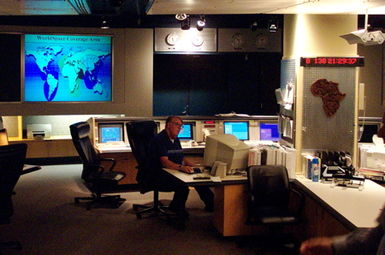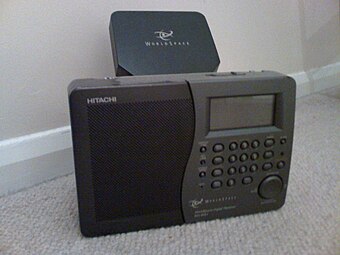Matra Marconi Space (MMS) was a Franco-British aerospace company.

Skynet is a family of military communications satellites, now operated by Airbus Defence and Space on behalf of the United Kingdom's Ministry of Defence (MoD). They provide strategic and tactical communication services to the branches of the British Armed Forces, the British intelligence agencies, some UK government departments and agencies, and to allied governments. Since 2015 when Skynet coverage was extended eastward, and in conjunction with an Anik G1 satellite module over America, Skynet offers near global coverage.
Digital radio is the use of digital technology to transmit or receive across the radio spectrum. Digital transmission by radio waves includes digital broadcasting, and especially digital audio radio services.
1worldspace, known for most of its existence simply as WorldSpace, is a defunct satellite radio network that in its heyday provided service to over 170,000 subscribers in eastern, southern and northern Africa, the Middle East, and much of Asia with 96% coming from India. It was profitable in India, with 450,000 subscribers.

A military satellite is an artificial satellite used for a military purpose. The most common missions are intelligence gathering, navigation and military communications.
AsiaStar is an American communications satellite which was operated by 1worldspace. It was constructed by Matra Marconi Space with Alcatel Space based on the Eurostar E2000+ bus design. Launch occurred on 21 March 2000, at 23:29:00 UTC. The launch was contracted by Arianespace, and used an Ariane 5G carrier rocket flying from ELA-3 at the Centre Spatial Guyanais. The INSAT-3B satellite was launched on the same rocket.
Badr-4 is an EADS Astrium-built communications satellite operated by Arabsat, launched 8 November 2006 on a Proton-M/Briz-M rocket. It provides fixed satellite communications services in C- and Ku-bands from the 26° East orbital position.
Astrium was an aerospace manufacturer subsidiary of the European Aeronautic Defence and Space Company (EADS) that provided civil and military space systems and services from 2006 to 2013. In 2012, Astrium had a turnover of €5.8 billion and 18,000 employees in France, Germany, the United Kingdom, Spain and the Netherlands. Astrium was a member of Institute of Space, its Applications and Technologies.
ETSI Satellite Digital Radio describes a standard of satellite digital radio. It is an activity of the European standardisation organisation ETSI.
HYLAS is a British satellite in geostationary orbit. HYLAS, which is an acronym for Highly Adaptable Satellite, is a communications satellite and was launched by the European Ariane 5 launch vehicle from the Guyana Space Centre at Kourou in French Guiana. It is located at the orbital location of 33.5 degrees west and will provide new and innovative services including High Definition Television (HDTV) and interactive satellite delivered broadband services. The satellite will help address the issue of poor broadband coverage in many parts of Europe which have less developed ground infrastructure.

Alphabus is a family of heavy geostationary communications satellites developed by a joint venture between Thales Alenia Space and EADS Astrium Satellites in France, with support of the Centre national d'études spatiales (CNES), the French space agency and the European Space Agency (ESA).
The DirecTV satellite fleet is a group of communications satellites located at various geostationary orbits that DirecTV uses for their satellite television service and HughesNet internet service. The "DirecTV" prefix in their names has been changed to "T".
Afghansat 1, formerly named Eutelsat W2M, Eutelsat 48B, Eutelsat 28B is a telecommunications satellite operated by Afghanistan's Ministry of Communications and Information Technology.
Hot Bird 13C, formerly Hot Bird 9, is a communications satellite operated by Eutelsat, launched 20 December 2008 aboard an Ariane 5ECA carrier rocket along with the Eutelsat W2M spacecraft. It was built by EADS Astrium, based on a Eurostar E3000 satellite bus. It was positioned in geosynchronous orbit at 13°E. After in-orbit testing it will provide communications services to Asia, Europe, Americas, North Africa and the Middle East, with 64 NATO J-band transponders.
Chollian, also known as Communication, Ocean and Meteorological Satellite 1 (COMS-1), was a South Korean satellite which was launched on 26 June 2010 and began operations on 1 April 2011. It was operated by the Korea Aerospace Research Institute, who used it for communication, oceanography, and meteorological observation.
Yahsat 1A is a communications satellite constructed by EADS Astrium and Thales Alenia Space for Al Yah Satellite Communications Company (Yahsat). It was launched in April 2011 from Arianespace's Guiana Space Centre in Kourou French Guiana in a dual payload launch with Intelsat New Dawn atop an Ariane 5 ECA rocket. Yahsat Y1A is based on the Eurostar E3000 satellite bus and had a launch mass of about 6000 kg. It is intended to provide Ku, Ka and C-band communications to the Middle East, Africa, Europe and Southwest Asia. It is in geosynchronous orbit at 52.5 degrees East.
Eutelsat 70B is a commercial communications satellite run by Eutelsat. It was launched on 3 December 2012 and is designed to provide telecommunication services for the Middle East, Central Asia, South East Asia and parts of Africa. It will replace Eutelsat 70A, which was previously known as Eutelsat W5. That satellite, which was launched in 2002, currently occupies the same 70.5° E location this satellite is intended for.
VNREDSat-1 is the first optical Earth Observing satellite of Vietnam; its primary mission is to monitor and study the effects of climate change, predict and take measures to prevent natural disasters, and optimise the management of Vietnam's natural resources.
Airbus Defence and Space is the division of Airbus SE responsible for the development and manufacturing of the corporation's defence and space products, while also providing related services. The division was formed in January 2014 during the corporate restructuring of European Aeronautic Defence and Space (EADS), and comprises the former Airbus Military, Astrium, and Cassidian divisions. It is the world's second-largest space company after Boeing and one of the top ten defence companies in the world.
Hot Bird 13B, known as Hot Bird 8 prior to 2012, is a geostationary communications satellite. Operated by Eutelsat, it provides direct-to-home (DTH) broadcasting services from geostationary orbit as part of Eutelsat's Hot Bird constellation at a longitude of 13° East.





